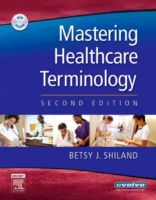The new edition of Mastering Healthcare Terminology offers a unique, powerful approach to understanding and using healthcare language to clearly communicate with other health care team members. Organized by body system, each chapter presents material in "chunks" - small learning segments of related concepts, terms, and abbreviations. These segments are immediately followed by exercises that reinforce and assess the reader's mastery of the material. End-of-chapter exercises encourage readers to apply what they've learned through case studies with accompanying healthcare reports, and a cumulative review tests their knowledge of previous chapters. Colorful illustrations and informative boxes and tables reinforce key concepts and make it easy to quickly locate important information. New features include more medical records, new sections on pediatrics and geriatrics; new appendices on imaging, laboratory procedures, and pharmacology; and an updated companion CD filled with helpful learning games and exercises.Organized by body system, each chapter presents material in "chunks" - small learning segments of related concepts, terms, and abbreviations. Each chapter contains a variety of short, engaging exercises that focus on knowledge, analysis, and application and take readers from simple to more complex tasks by building on knowledge gained from previous exercises. Anatomy and physiology sections at the beginning of each body system chapter prepare readers to learn medical terms relevant to that particular body system.All pathology, procedures, interventions, and diagnostics terms are presented in helpful tables that include the pronunciation, origin, and meaning of the most frequently occurring diseases and disorders and their treatments.End-of-chapter exercises include a chapter review, a cumulative review of previous chapters, case studies, and medical records.The most current healthcare terms are presented to ensure that readers are learning terms they will actually encounter in practice. Includes diagnoses, procedures, and treatments that appear in sources such as the Agency for Healthcare Research and Quality's Healthcare Cost and Utilization Project, as well as reports from the World Health Organization and the U.S. National Vital Statistics.Behavioral health terminology is covered in a separate chapter, ensuring in-depth coverage.Complementary and alternative medicine terms - used frequently in discussions of mainstream healthcare - are featured throughout.Pharmacology terms are presented in each chapter and in an appendix for quick and easy reference.Diagnostic Procedures boxes introduce readers to word origins and definitions related to terms used to describe various procedures.Careers boxes help readers explore various healthcare career options.Boxes such as Did You Know? and Be Careful! appear in the margins and highlight important facts and precautions.More medical records throughout each chapter familiarize readers with the forms and records they will see and use in the clinical setting.Three new appendices address key issues related to Diagnostic Imaging, Laboratory Procedures and Pharmacology.Each chapter features new decoding exercises.Neoplasm tables in each chapter help readers learn oncological terms by body system.Chapter at a Glance sections give a brief overview of the word parts, key terms, and anatomy and physiology readers will learn in each chapter.The Companion CD-ROM, included with the book, has been completely updated and offers a wealth of interactive features such as: New electronic flashcards Body Spectrum anatomy coloring book A 5,000 term glossary with Spanish translations and pronunciations New interactive games - Wheel of Terminology, Quiz Show, and Triage. Listen and Spell exercises WordshopA new lay-flat spiral binding is very reader-friendly.Case Studies with accompanying Medical Reports help readers make the connection between real-life situations and the corresponding forms they will encounter in the clinical setting.Age Matters boxes highlight important concepts and terminology for both pediatric and geriatric patients.
